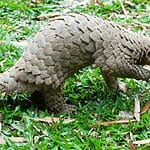Discover the fascinating world of animals with spikes, nature’s own warriors equipped with an arsenal of sharp defenses. From the African savannas to the depths of the ocean, these creatures’ spiky features are not just for show—they’re vital for survival.
Uncover the secrets behind their prickly exteriors, the roles they play in their ecosystems, and the urgent conservation efforts needed to protect them.
Key Takeaways:
- Birds with spikes, such as the Gray Crowned Crane and Hoopoe, use their spiky features for courtship displays and defense, with many facing conservation challenges due to habitat loss and human disturbances.
- Mammals like the North American Porcupine and European Hedgehog have evolved spikes as a defense mechanism, and their survival is threatened by human conflict and habitat fragmentation, necessitating protective measures.
- Reptiles, including the Thorny Devil and Bearded Dragon, exhibit spikes for defense, communication, and environmental adaptation, with their continued existence reliant on habitat conservation and responsible pet trade practices.
- Sea creatures with spikes, such as the Crown Of Thorns Starfish and Red Lionfish, use their spines for protection and predation, playing complex roles in marine ecosystems that require careful management to maintain ecological balance.
- Spiky insects like the Thorn Bug and Buff-tip Moth Caterpillar utilize their spikes for camouflage and defense, highlighting the intricate relationships within ecosystems and the importance of habitat conservation for biodiversity.
List of Animals With Spikes
Quick Answer: Animals with spikes, such as the Gray Crowned Crane and porcupines, use them for defense, mating, and communication across various ecosystems, necessitating conservation efforts.
| Species | Description | Habitat and Behavior | Conservation Status and Efforts |
| Gray Crowned Crane | Uses its spiky crown for courtship displays. | Found in African wetlands, feeds on insects, reptiles, and small mammals. | Listed as endangered due to habitat loss and human disturbances. |
| Hoopoe | Recognizable by its striking spiky crown of feathers. | Adaptable, inhabits Europe, Asia, and Africa, primarily feasts on insects. | Not currently endangered, but habitat monitoring is necessary. |
| Greater Sage-Grouse | Known for its spiky appearance during mating rituals. | Native to the American West’s sagebrush ecosystem, feeds on sagebrush and insects. | Habitat under threat from development and land use changes. |
| Secretary Bird | Sports long legs with spiky feathers, aiding in hunting snakes. | Roams the African savannas, diet consists of snakes, insects, and small mammals. | Not currently endangered, but habitat changes and human encroachment are risks. |
| Eurasian Eagle-Owl | Features ear tufts that resemble spikes, adding to its intimidating presence. | Found across Europe and Asia, hunts at night for small mammals and birds. | Monitoring of populations is important to ensure they remain a commanding figure in habitats. |
1. Birds with Spikes
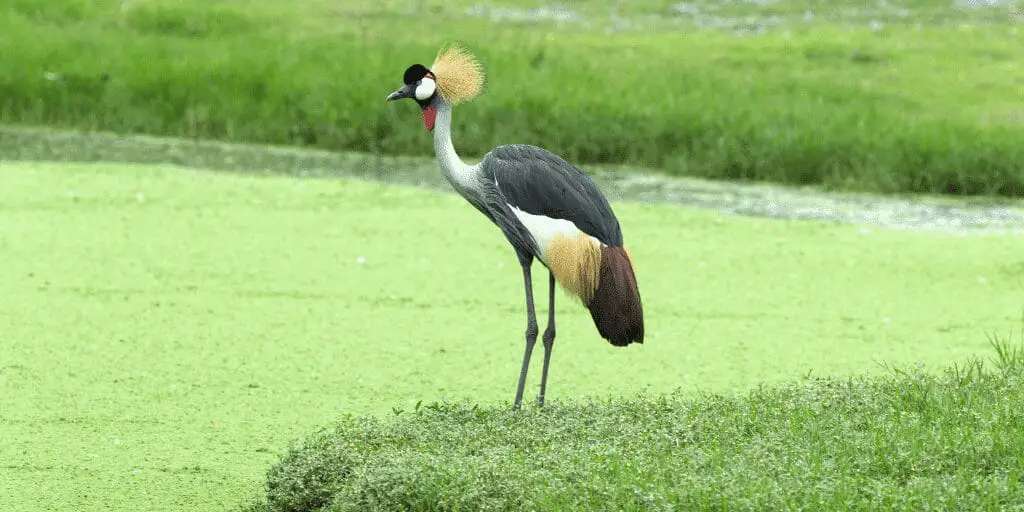
Birds are some of the most diverse creatures on the planet, and their adaptations can be quite fascinating. Among these adaptations are spikes, which can be found on various parts of their bodies.
These spiky features serve a range of purposes, from playing a role in mating rituals to acting as a defense mechanism. Let’s take a closer look at some of these birds and the significance of their spikes.
Gray Crowned Crane: Uses its spiky crown for courtship displays
The Gray Crowned Crane is a sight to behold with its elegant golden spikes that crown its head. These aren’t just for show; they’re a key part of the crane’s courtship ritual, where they engage in a complex dance to woo their potential mates.
Found in the wetlands of Africa, these cranes have a varied diet that includes insects, reptiles, and small mammals, making them an integral part of the local ecosystem. Unfortunately, their numbers are dwindling, and they are currently listed as endangered.
Habitat loss and human disturbances have taken a toll on their populations. Conservation efforts are in place, aiming to protect the wetlands that are crucial for their survival and breeding.
Hoopoe: Recognizable by its striking spiky crown of feathers
The Hoopoe is another bird that boasts a remarkable spiky crown. When it fans out these feathers, it’s a display that’s hard to miss. These birds are adaptable, making homes across Europe, Asia, and Africa, and they primarily feast on insects.
The Hoopoe has a special place in many cultures and is often associated with wisdom and virtue. Its spiky crown isn’t just for show; it’s a tool for communication, attracting mates, and even intimidating predators.
The Hoopoe’s nesting habits are unique as they often take over the abandoned burrows of other animals, and while they are not currently endangered, their habitats must be monitored to ensure their continued survival.
Greater Sage-Grouse: Known for its spiky appearance during mating rituals
The Greater Sage-Grouse’s mating display is nothing short of a spectacle. Males showcase their spiky tail feathers and puff up their chests in an impressive display to attract females.
These birds are native to the sagebrush ecosystem of the American West, where they feed on sagebrush and insects. Their habitat is under threat from development and land use changes, making conservation efforts vital.
Protecting the sagebrush ecosystem is not only important for the grouse but also for the myriad of other species that depend on it.
Secretary Bird: Sports long legs with spiky feathers, aiding in hunting snakes
With its long legs and striking spiky feathers at the back of its head, the Secretary Bird is an exceptional hunter, known for its ability to stomp snakes to death. These birds roam the African savannas, where they play a crucial role in controlling pest populations.
Their diet consists of snakes, insects, and small mammals. While they are not currently endangered, habitat changes and human encroachment pose risks to their survival. Preserving the savannas is essential for maintaining the delicate balance of this ecosystem.
Eurasian Eagle-Owl: Features ear tufts that resemble spikes, adding to its intimidating presence
The Eurasian Eagle-Owl is a formidable presence in the night sky, with ear tufts that give the illusion of spikes, adding to its intimidating demeanor. These owls are found across Europe and Asia, where they hunt at night, preying on a variety of small mammals and other birds.
They hold a mystical place in folklore and mythology, often seen as symbols of wisdom. While they are not currently facing critical threats, it’s important to monitor their populations to ensure they remain a commanding figure in their habitats.
Mammals with Spikes and Their Ecological Significance
| Species | Description | Habitat and Diet | Conservation Status and Efforts |
| North American Porcupine | Defends itself with sharp, barbed quills. | Inhabits forests and wooded areas, has a herbivorous diet. | Conflicts with humans impact conservation status. |
| European Hedgehog | Uses its spines for protection when threatened. | Found in gardens, forests, and meadows across Europe, insectivorous. | Faces habitat fragmentation and road mortality. |
| Short-beaked Echidna | An egg-laying mammal covered in spines. | Spread across Australia and New Guinea, feeds on ants and termites. | Habitat protection is crucial for this unique species. |
| Lowland Streaked Tenrec | Utilizes its quills for defense and communication. | Native to Madagascar, plays a role in soil aeration and seed dispersal. | Threatened by habitat destruction and fragmentation. |
| African Crested Porcupine | Known for its long quills used in defense and sound production. | Nocturnal herbivore living in small family groups. | Human-wildlife conflict highlights the need for sustainable coexistence strategies. |
| Desert Hedgehog | Adapted to arid environments, uses spikes for protection. | Inhabits deserts to scrublands in Africa and the Middle East, diet includes desert insects. | Habitat degradation is a concern for their population dynamics. |
2. Mammals with Spikes
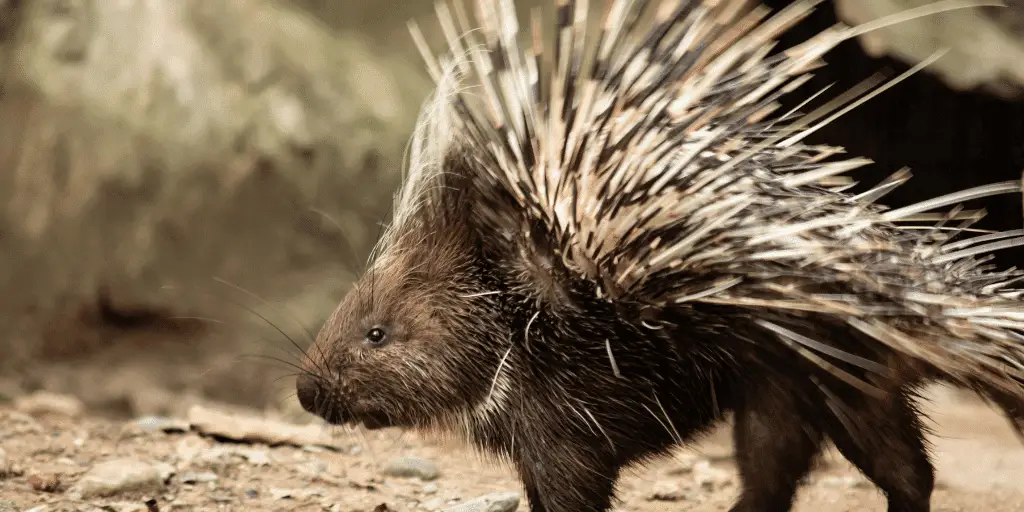
Transitioning into the mammalian realm, we find that spikes are not just an oddity but a crucial defense mechanism for a variety of species. These mammals, ranging from the well-known porcupine to the lesser-known tenrec, have evolved spikes in fascinating ways to ensure their survival.
The spikes, which vary in structure and function, play a vital role in the lives of these creatures, aiding in defense, communication, and sometimes even reproduction. As we explore the habitats, diets, and unique behaviors of these spiky mammals, we also consider the evolutionary significance of their spikes and the conservation efforts needed to protect them from threats like habitat loss and poaching.
Porcupine (North American): Defends itself with sharp, barbed quills
The North American Porcupine is a master of defense, sporting a coat of sharp, barbed quills that deter even the most determined of predators. These quills are essentially modified hairs, coated with keratin, which makes them incredibly tough. When a threat is perceived, the porcupine’s quills stand on end, creating an intimidating display.
Contrary to popular belief, porcupines cannot shoot their quills, but the barbs make them difficult and painful to remove once embedded. These solitary creatures make their home in forests and wooded areas, feasting on a herbivorous diet. While their quills are an effective defense, they have led to conflicts with humans, impacting their conservation status.
Hedgehog (European): Uses its spines for protection when threatened
The European Hedgehog is a charming creature with a coat of spines that it uses to protect itself when threatened. By curling into a tight ball, the hedgehog ensures that only its spines are exposed, safeguarding its softer underbelly. These nocturnal mammals are insectivores, contributing to the control of insect populations in gardens, forests, and meadows across Europe.
However, they face significant challenges due to habitat fragmentation and road mortality. Efforts to create hedgehog-friendly spaces and ensure habitat connectivity are vital for their continued survival.
Echidna (Short-beaked): An egg-laying mammal with a body covered in spines
The Short-beaked Echidna is a remarkable creature, not only for its spiny coat but also because it is one of the few mammals that lay eggs. These monotremes use their spines for defense while their snouts and long tongues are perfectly adapted for feeding on ants and termites.
Echidnas are solitary animals, found across Australia and New Guinea, and play a crucial role in their ecosystems by aerating the soil and controlling insect populations. Their unique reproductive strategy and evolutionary history make them a symbol of Australia’s unique wildlife, and conservation efforts are essential to protect their habitats.
Tenrec (Lowland Streaked): Utilizes its quills for defense and communication
The Lowland Streaked Tenrec, native to Madagascar, is a small mammal with striking black and yellow striped quills. These quills serve a dual purpose: defense against predators and communication with fellow tenrecs through sound vibrations.
Their omnivorous diet, significant role in soil aeration and seed dispersal, and one of the largest litter sizes for mammals underscore their importance in the ecosystem. However, they face threats from habitat destruction and fragmentation, making conservation efforts in Madagascar critical for their survival.
African Crested Porcupine: Known for its long quills used in defense and sound production
The African Crested Porcupine is the largest rodent in Africa, equipped with long, sturdy quills that it uses to defend itself. When threatened, it can rattle these quills as a warning before charging backward to stab with them.
These nocturnal herbivores live in small family groups and play a role in seed dispersal, though they can sometimes damage crops. Conservation concerns for these porcupines include human-wildlife conflict, highlighting the need for sustainable coexistence strategies.
Desert Hedgehog: Adapted to arid environments, using spikes for protection
The Desert Hedgehog is a small mammal adept at surviving in arid environments. Its spines provide protection, and it shares the hedgehog’s ability to curl into a ball when threatened. These creatures are nocturnal, which helps them avoid the extreme heat of the day, and their diet includes a variety of desert insects and small vertebrates.
The desert hedgehog’s habitat spans deserts to scrublands in Africa and the Middle East, and while these ecosystems are crucial, they are threatened by habitat degradation. Understanding and supporting the population dynamics of desert hedgehogs is essential for their conservation.
3. Reptiles with Spikes
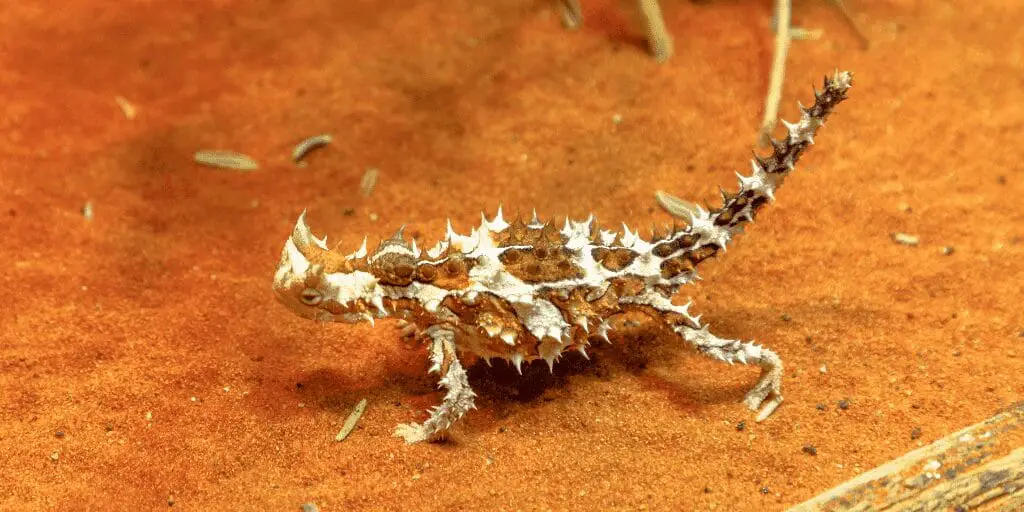
The animal kingdom is rife with examples of evolution’s ingenuity, and perhaps nowhere is this more evident than in the array of reptiles sporting spikes. These reptiles have developed their spiky features over millennia, adapting to their environments in ways that fascinate and inspire.
From the arid deserts of Australia to the lush forests of Madagascar, spiky reptiles have evolved unique ways to defend themselves, attract mates, and even regulate their body temperature. Let’s explore some of these remarkable creatures and the roles they play in their ecosystems.
Thorny Devil: Exhibits a spiky armor for defense and temperature regulation
The Thorny Devil, a native of Australia’s harsh deserts, is a masterclass in adaptation. Its entire body is covered with conical spikes that serve as a formidable deterrent to would-be predators. But these spikes aren’t just for defense; they also play a crucial role in the lizard’s survival by collecting water.
Ingeniously, the Thorny Devil can direct water from any part of its body to its mouth through capillary action, using grooves between its spikes. This reptile’s diet is almost exclusively ants, and it can change color to regulate its body temperature or blend into its surroundings.
Indigenous Australian cultures hold the Thorny Devil in high regard, and efforts are ongoing to protect its habitat from degradation.
Bearded Dragon: Has spiky skin that helps in predator deterrence
The Bearded Dragon is a charismatic reptile with a spiky demeanor that belies its popularity as a pet. When threatened, it can puff out its throat, displaying a spiky “beard” that can darken dramatically.
Native to various Australian habitats, from deserts to woodlands, the Bearded Dragon is an omnivore that enjoys a varied diet. It communicates through body language, such as arm waving, and requires sunlight to regulate its body temperature.
The pet trade has made the Bearded Dragon well-known globally, but it’s important to remember that wild populations are affected by habitat loss, making conservation awareness crucial.
Black Spiny-Tailed Iguana: Uses its spiky tail for defense against predators
In the forests and rocky regions of Central and South America, the Black Spiny-Tailed Iguana is a sight to behold. Its spiky tail is not just for show; it serves as an effective weapon against predators.
This iguana loves to bask in the sun and has a diet that evolves from herbivorous in youth to more omnivorous with age. The Black Spiny-Tailed Iguana faces threats from habitat destruction and the pet trade, highlighting the need for conservation efforts to protect these agile reptiles.
Spiny Chameleon (Jeweled): Camouflages with its environment using spiky projections
The Spiny Chameleon, hailing from Madagascar, uses its spiky projections to blend seamlessly into its environment. This insectivorous reptile has a fascinating reproductive strategy, with males displaying vibrant colors to attract mates.
However, the Spiny Chameleon is under threat from habitat destruction and the illegal pet trade. Conservation of Madagascar’s forests is vital to ensure the survival of this and many other unique species.
Texas Horned Lizard: Can shoot blood from its eyes as a defense mechanism
Perhaps one of the most bizarre defense mechanisms in the reptile world belongs to the Texas Horned Lizard, which can shoot blood from its eyes to startle predators.
Adapted to the arid and semi-arid regions of the American Southwest, this lizard’s diet is predominantly ants. It has become a cultural icon, often referred to as the “horny toad,” and conservation efforts are focused on protecting its habitat and the ant populations it relies on.
Rhinoceros Iguana: Features horn-like structures on its snout, adding to its spiky appearance
The Rhinoceros Iguana, with its distinctive horn-like snout structures, is a commanding presence in the Caribbean. Its diet helps maintain ecological balance through seed dispersal, and its social behaviors are a study in reptilian interaction.
Unfortunately, this species faces threats from habitat destruction, hunting, and the pet trade. Protecting the Rhinoceros Iguana’s habitat and enforcing pet trade regulations are critical for its continued survival.
4. Sea Creatures with Spikes
The ocean is a vast, mysterious world, home to an array of creatures that seem to belong more to the realm of fantasy than reality. Among these, some of the most intriguing are those adorned with spikes. These natural defenses serve a variety of purposes, from deterring predators to aiding in the hunt for food.
Let’s delve into the lives of these spiky sea dwellers, exploring how they’ve adapted to survive in the diverse habitats of the world’s oceans, from the sunlit shallows of coral reefs to the mysterious depths of the deep sea.
Crown Of Thorns Starfish: A venomous starfish with sharp spines for protection
The Crown Of Thorns Starfish is notorious for its venomous spines that cover its body, providing defense against predators. It plays a dual role in coral reef ecosystems, both as a predator of coral and a contributor to reef health dynamics, especially when populations explode.
Found widely across the Indo-Pacific region, its reproductive strategies and the challenges in managing outbreaks to protect coral reefs are critical. Ongoing research and conservation efforts aimed at controlling its population underscore the delicate balance between the starfish and coral reef health.
Sea Urchin (Red): Covered in sharp spines that can inflict painful wounds
Enter the world of the Red Sea Urchin, renowned for its long, sharp spines that serve as a formidable defense mechanism against predators. Its habitat in rocky, shallow waters, along with a diet predominantly of algae, positions it as a crucial player in maintaining marine ecosystem health by controlling algae populations.
This sea urchin’s significance extends beyond its ecological role, touching upon research into longevity and the understanding of aging processes, highlighting the need for sustainable management of their populations.
Red Lionfish: Features venomous spiky fins for defense and predation
The invasive Red Lionfish, with its striking appearance and venomous spiky fins, serves dual purposes: defense against predators and immobilizing prey.
Originally from the Indo-Pacific, its presence in the Atlantic, Caribbean, and Mediterranean has raised concerns due to its ecological impact on local fish populations and reef health. Efforts to control its population, including organized culls and promoting its consumption, are vital for protecting native marine life.
Long-Spine Porcupinefish: Inflates its body, erecting spines to deter predators
The Long-Spine Porcupinefish is fascinating for its unique defense mechanism of inflating its body and erecting its spines, making it appear larger to predators.
Found in tropical and subtropical oceans, it hides in crevices to avoid predators and is one of the most poisonous vertebrates in the world due to the tetrodotoxin it harbors. This highlights the incredible survival strategies of the porcupinefish and the need for caution among divers and fishermen.
Whiptail Stingray: Utilizes a venomous spine in its tail for defense
The Whiptail Stingray, with its long, slender tail equipped with venomous spines, epitomizes defense mechanisms in the marine world. As a bottom-dweller feeding on mollusks and crustaceans, it plays a significant role in controlling invertebrate populations, emphasizing the importance of marine habitat conservation.
Spiny Starfish (Marthasterias glacialis): Known for its sharp spines, aiding in protection and predation
The Spiny Starfish, with its sharp spines for protection and predation, thrives in rocky seabeds and coral reefs. Its omnivorous diet and role in the marine food web, coupled with its ability to regenerate lost arms, showcases its adaptations for survival and contribution to marine biodiversity.
5. Spiky Insects
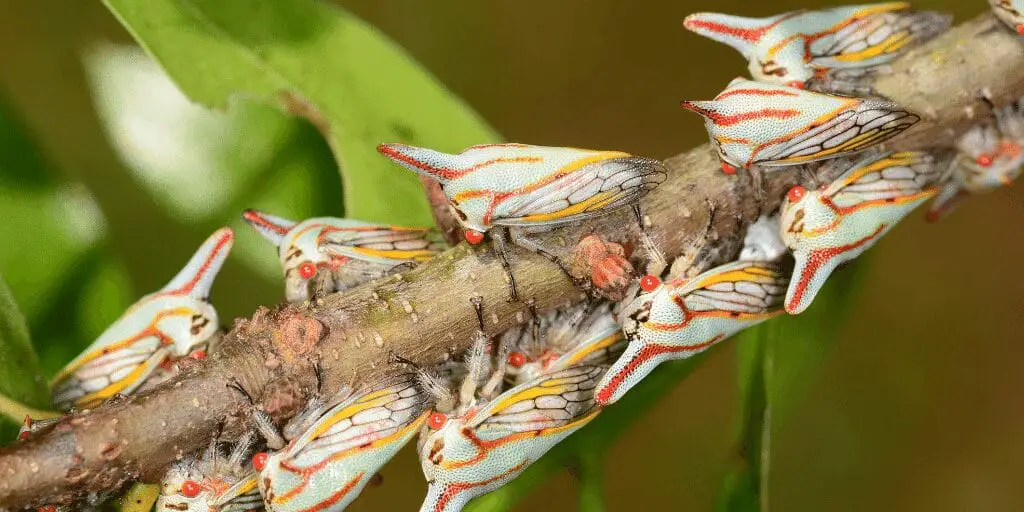
Shifting our focus to the terrestrial realm, we discover an equally intriguing world of insects adorned with spikes. These natural armours are not just for show; they serve crucial roles in camouflage, defense, and deterrence.
From the deceptive Thorn Bug to the protective spines of the Buff-tip Moth Caterpillar, each spiky insect has adapted uniquely to its environment.
Their habitats vary widely, as do their diets and survival strategies, but all share the common thread of utilising their spikes to navigate the challenges of the wild. These insects are vital components of ecosystems, acting as pollinators, decomposers, and a food source for other animals. Exploring the world of spiky insects opens a window into the significance of conserving their habitats for biodiversity.
Thorn Bug: Mimics thorns for camouflage and defense against predators
The Thorn Bug is a master of disguise, using its thorn-like appearance to blend seamlessly into the branches and leaves it inhabits.
Feeding on plant sap, these bugs can impact plant health but also play a key role in their ecosystem, serving as prey for birds and other insectivores. Their clever mimicry and the interconnectedness of plant and insect life are fascinating aspects of their existence.
Spiny Leaf Insect (Female): Uses its spiky appearance for camouflage and protection
The female Spiny Leaf Insect takes camouflage to the next level with spiky projections that make her indistinguishable from the vegetation she calls home. Living in forests, her herbivorous diet and the ability of some species to reproduce without a male (parthenogenesis) add layers of intrigue to her story. She is a vital leaf consumer and serves as prey for birds and small mammals, highlighting the wonders of insect camouflage.
Giant Spiny Stick Insect: Exhibits spines for defense against predators
In the dense, humid environment of tropical forests, the Giant Spiny Stick Insect uses its body’s spines as a formidable defense mechanism. Mimicking twigs or branches, it remains motionless to avoid detection by predators. Its diet consists mainly of leaves, and its existence underscores the importance of forest conservation for the survival of such unique species.
Spiny Devil Katydids: Utilizes spikes for camouflage and defense in the rainforest
The Spiny Devil Katydids, with their spiky bodies, blend into the rainforest undergrowth, deterring predators with their formidable appearance. Their habitat in the Amazon, diet of leaves and flowers, and nocturnal activities make them key players in nutrient cycling. However, they face threats from deforestation and habitat fragmentation, highlighting the critical need for conservation efforts in the Amazon.
Buff-tip Moth Caterpillar: Resembles a twig with spiky protrusions for defense
The Buff-tip Moth Caterpillar’s twig-like appearance and spiky protrusions are nature’s way of protecting it from predators. Inhabiting deciduous forests, its diet of leaves from various trees positions it as an important consumer in forest ecosystems. The transformation into the Buff-tip Moth, which also showcases remarkable camouflage skills, underscores the importance of caterpillars in ecosystems and the need for preserving their natural habitats.
Crowned Hairstreak Butterfly: The larvae have spiky protrusions, deterring predators
The larvae of the Crowned Hairstreak Butterfly are equipped with spiky protrusions to deter predators, ensuring their survival into adulthood. As adults, they inhabit tropical and subtropical forests, feeding on flower nectar and playing a role in pollination. The challenges they face from habitat loss and climate change make conservation efforts vital for protecting these beautiful pollinators and their role in ecosystems.








